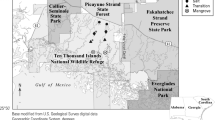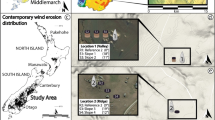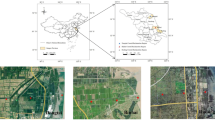Abstract
Accelerating sea-level rise poses a threat to mangroves and salt marshes. Sediment accretion on the soil surface and belowground root production is proposed to increase soil elevation enabling these intertidal habitats to maintain their position relative to mean sea level. However, shallow soil subsidence is frequently observed, which may cancel out or even outweigh the positive effects of surface accretion and root production on soil elevation gains. The processes that lead to shallow soil subsidence have not often been investigated. Here, we used computed tomography (CT) imaging to determine the volume of coarse pores in the top 20 cm of 30-cm-deep soil cores collected from mangroves and salt marshes within Moreton Bay, eastern Australia. The four field sites have long-term observations of variation in soil surface elevation gain, surface accretion rate, and shallow subsidence rate using the rod surface elevation table-marker horizon (RSET-MH) method. Over our sites, we found that the rates of shallow soil subsidence were positively related to the volume of soil coarse pores and soil clay and silt content rather than to the volume of fine pores or total porosity or other soil properties. In turn, the volume of soil coarse pores was positively related to the volume of animal burrows and root mass. Fine-pore volume and total porosity of soils were negatively associated with soil bulk density, which was in turn negatively related to soil organic matter content. Our results indicate influences of differently sized soil pores in shallow soil subsidence and suggest that animal burrowing may play a role in shallow soil subsidence.




Similar content being viewed by others
References
Abal, E.G., W.C. Dennison, and P.F. Greenfield. 2001. Managing the Brisbane River and Moreton Bay: an integrated research/management program to reduce impacts on an Australian estuary. Water Science and Technology 43 (9): 57–70.
Alongi, D.M. 2014. Carbon cycling and storage in mangrove forests. Annual Review of Marine Science 6: 195–219.
Atwood, T.B., R.M. Connonlly, E.G. Ritchie, C.E. Lovelock, M.R. Heithaus, G.C. Hays, J.W. Fourqurean, and P.I. Macreadie. 2015. Predators help protect carbon stocks in blue carbon ecosystems. Nature Climate Change 5: 1038–1045.
Barbier, E.B., S.D. Hacker, C. Kennedy, E.W. Koch, A.C. Stier, and B.R. Silliman. 2011. The value of estuarine and coastal ecosystem services. Ecological Monographs 81: 169–193.
Blum, L.K., and E. Davey. 2013. Below the salt marsh surface: visualization of plant roots by computer-aided tomography. Oceanography 26: 85–87.
Cahoon, D.R., and R.E. Turner. 1989. Accretion and canal impacts in a rapidly subsiding wetland I1. Feldspar marker horizon technique. Estuaries 12: 260–268.
Cahoon, D.R., D.J. Reed, and J.W. Day Jr. 1995. Estimating shallow subsidence in microtidal salt marshes of the southeastern United States: Kaye and Barghoorn revisited. Marine Geology 128: 1–9.
Cahoon, D.R., J.C. Lynch, P. Hensel, R. Boumans, B.C. Perez, B. Segura, and J.W. Day Jr. 2002a. High-precision measurements of wetland sediment elevation, I. Recent improvements to the sedimentation-erosion table. Journal of Sedimentary Research 72: 730–733.
Cahoon, D.R., J.C. Lynch, B.C. Perez, B. Segura, R. Holland, C. Stelly, G. Stephenson, and P. Hensel. 2002b. High-precision measurements of wetland sediment elevation, II The rod surface elevation table. Journal of Sedimentary Research 72: 734–736.
Cahoon, D.R., P. Hensel, J. Rybczyk, K.L. McKee, C.E. Proffitt, and B.C. Perez. 2003. Mass tree mortality leads to mangrove peat collapse at Bay Islands, Honduras after Hurricane Mitch. Journal of Ecology 91: 1093–1105.
Cannicci, S., D. Burrows, S. Fratini, T.J.I.I.I. Smith, J. Offenberg, and F. Dahdouh-Guebas. 2008. Faunal impact on vegetation structure and ecosystem function in mangrove forests: A review. Aquatic Botany 89: 186–200.
Chambers, L.G., H.E. Steinmuller, and J.L. Breithaupt. 2019. Toward a mechanistic understanding of “peat collapse” and its potential contribution to coastal wetland loss. Ecology 100: e02720.
Coverdale, T.C., E.E. Axelman, C.P. Brisson, E.W. Young, A.H. Altieri, and M.D. Bertness. 2013. New England salt marsh recovery: opportunistic colonization of an invasive species and its non-consumptive effects. PLoS One 8: e73823.
Davey, E., C. Wigand, R. Johnson, K. Sundberg, J. Morris, and C.T. Roman. 2011. Use of computed tomography imaging for quantifying coarse roots, rhizomes, peat, and particle densities in marsh soils. Ecological Applications 21 (6): 2156–2171.
DeLaune, R.D., R.H. Baumann, and J.G. Gosselink. 1983. Relationships among vertical accretion, coastal submergence, and erosion in a Louisiana Gulf Coast marsh. Journal of Sedimentary Research 53: 147–157.
DeLaune, R.D., J.A. Nyman, and W.H. Patrick Jr. 1994. Peat collapse, ponding and wetland loss in a rapidly submerging coastal marsh. Journal of Coastal Research 10: 1021–1030.
Dennison, W.C., and E.G. Abal. 1999. SE Queensland Regional Water Quality Management Strategy. In Moreton Bay Study. A Scientific Basis for the Healthy Waterways Campaign, 245. Brisbane: Brisbane City Council.
Dexter, A.R. 2004. Soil physical quality: Part I. Theory, effects of soil texture, density, and organic matter, and effects on root growth. Geoderma 120: 201–214.
Dokka, R.K. 2006. Modern-day tectonic subsidence in coastal Louisiana. Geology 34: 281–284.
Friess, D.A., K.W. Krauss, E.M. Horstman, T. Balke, T.J. Bouma, D. Galli, and E.L. Webb. 2011. Are all intertidal wetlands naturally created equal? Bottlenecks, thresholds and knowledge gaps to mangrove and saltmarsh ecosystems. Biological Reviews 87: 346–366.
Harvey, J.W., and W.K. Nuttle. 1995. Fluxes of water and solute in a coastal wetland sediment. 2. Effect of macropores on solute exchange with surface water. Journal of Hydrology 164: 109–125.
Huang, B., and D.S. NeSmith. 1999. Soil aeration effects on root growth and activity. Acta Horticulturae 504: 41–52.
Keogh, M.E., and T.E. Törnqvist. 2019. Measuring rates of present-day relative sea-level rise in low-elevation coastal zones: a critical evaluation. Ocean Science 15: 61–73.
Kooistra, M.J. 1994. Effects of compaction on soil microstructure. In Soil Compaction in Crop Production, ed. B.D. Soane and C. Van Ouwerkerk, 91–111. Amsterdam: Elsevier.
Kristensen, E. 2008. Mangrove crabs as ecosystem engineers: with emphasis on sediment processes. Journal of Sea Research 59: 30–43.
Kristensen, E., and D.M. Alongi. 2006. Control by fiddler crabs (Uca vocans) and plant roots (Avicennia marina) on carbon, iron, and sulfur biogeochemistry in mangrove sediment. Limnology and Oceanography 51: 1557–1571.
Kristensen, E., and J.E. Kostka. 2005. Macrofaunal burrows and irrigation in marine sediment: microbiological and biogeochemical interactions. In Interactions between Macro– and Microorganisms in Marine Sediments, ed. E. Kristensen, R.R. Haese, and J.E. Kostka, 125–158. Washington, DC: American Geophysical Union.
Lee, S.Y. 1998. Ecological role of grapsid crabs in mangrove ecosystems: a review. Marine and Freshwater Research 49: 335–343.
Lovelock, C.E., M.C. Ball, K.C. Martin, and I.C. Feller. 2009. Nutrient enrichment increases mortality of mangroves. PLoS One 4: e5600.
Lovelock, C.E., V. Bennion, A. Grinham, and D.R. Cahoon. 2011. The role of surface and subsurface processes in keeping pace with sea level rise in intertidal wetlands of Moreton Bay, Queensland, Australia. Ecosystems 14: 745–757.
Lovelock, C.E., D.R. Cahoon, D.A. Friess, G.R. Guntenspergen, K.W. Krauss, R. Reef, L. Rogers, M. Saunders, F. Sidik, A. Swales, N. Saintilan, L.X. Thuyen, and T. Tran. 2015a. Vulnerability of Indo pacific mangrove forests to sea level rise. Nature 526 (7574): 559–563.
Lovelock, C.E., M.F. Adame, V. Bennion, M. Hayes, R. Reef, N. Santini, and D.R. Cahoon. 2015b. Sea level and turbidity controls on mangrove soil surface elevation change. Estuarine, Coastal and Shelf Science 153: 1–9.
McKee, K.L., D.R. Cahoon, and I.C. Feller. 2007. Caribbean mangroves adjust to rising sea level through biotic controls on change in soil elevation. Global Ecology and Biogeography 16: 545–556.
Mills, M., J.X. Leon, M.I. Saunders, J. Bell, Y. Liu, J. O’Mara, C.E. Lovelock, P.J. Mumby, S. Phinn, H.P. Possingham, V. Tulloch, K. Mutafoglu, T. Morrison, D. Callaghan, T. Baldock, C.J. Klein, and O. Hoegh-Guldberg. 2016. Reconciling development and conservation under coastal squeeze from rising sea-level. Conservation Letters 9: 361–368.
Morrisey, D.J., T.H. DeWitt, D.S. Roper, and R.B. Williamson. 1999. Variation in the depth and morphology of burrows of the mud crab Helice crassa among different types of intertidal sediment in New Zealand. Marine Ecology Progress Series 182: 231–242.
Morton, R.A., J.C. Bernier, K.W. Kelso, and J.A. Barras. 2010. Quantifying large-scale historical formation of accommodation in the Mississippi Delta. Earth Surface Processes and Landforms 35: 1625–1641.
Nimmo, J.R. 2004. Porosity and pore size distribution. In Encyclopedia of Soils in the Environment, ed. D. Hillel, vol. 3, 295–303. London: Elsevier.
Nuttle, W.K., H.F. Hemond, and K.D. Stolzenbach. 1990. Mechanisms of water storage in salt marsh sediments: the importance of dilation. Hydrological Processes 4: 1–13.
Nyman, J.A., R.D. Delaune, and W.H. Patrick. 1990. Wetland soil formation in the rapidly subsiding Mississippi River Deltaic Plain: mineral and organic matter relationships. Estuarine, Coastal and Shelf Science 31: 57–69.
Oualmakran, M., B.C.N. Mercatoris, and B. François. 2016. Pore-size distribution of a compacted silty soil after compaction, saturation, and loading. Canadian Geotechnical Journal 53: 1902–1909.
Paine, J.G. 1973. Subsidence of the Texas coast: inferences from historical and late Pleistocene sea levels. Tectonophysics 222: 445–458.
Pierret, A., Y. Capowiez, L. Belzunces, and C.J. Moran. 2002. 3D reconstruction and quantification of macropores using X-ray computed tomography and image analysis. Geoderma 106: 247–271.
Pronger, J., L.A. Schipper, R.B. Hill, D.I. Campbell, and M. McLeod. 2014. Subsidence rates of drained agricultural peatlands in New Zealand and the relationship with time since drainage. Journal of Environmental Quality 43 (4): 1442–1449.
Richard, G., I. Cousin, J.F. Sillon, A. Bruand, and J. Guérif. 2001. Effect of compaction on the porosity of a silty soil: influence on unsaturated hydraulic properties. European Journal of Soil Science 52: 49–58.
Rogers, K., K.M. Wilton, and N. Saintilan. 2006. Vegetation change and surface elevation dynamics in estuarine wetlands of southeast Australia. Estuarine, Coastal and Shelf Science 66: 559–569.
Rojstaczer, S., and S.J. Deverel. 1995. Land subsidence in drained histosols and highly organic mineral soils of California. Soil Science Society of America Journal 59: 1162–1167.
Rühlmann, J., M. Körschens, and J. Graefe. 2006. A new approach to calculate the particle density of soils considering properties of the soil organic matter and the mineral matrix. Geoderma 130: 272–283.
Runting, R.K., C.E. Lovelock, H.L. Beyer, and J.R. Rhodes. 2017. Costs and opportunities for preserving coastal wetlands under sea level rise. Conservation Letters 10: 49–57.
Sammartino, S., A. Lissy, C. Bogner, R. Van Den Bogaert, Y. Capowiez, S. Ruy, and S. Cornu. 2015. Identifying the functional macropore network related to preferential flow in structured soils. Vadose Zone Journal 14 vzj2015.05.0070.
Sequi, P., and R. Aringhieri. 1977. Destruction of organic matter by hydrogen peroxide in the presence of pyrophosphate and its effect on soil specific surface area. Soil Science Society of America Journal 41: 340–342.
Stieglitz, T., P.V. Ridd, and P. Muller. 2000. Passive irrigation and functional morphology of crustacean burrows in a tropical mangrove swamp. Hydrobiologia 421: 69–76.
Swales, A., P. Denys, V.I. Pickett, and C.E. Lovelock. 2016. Evaluating deep subsidence in a rapidly-accreting mangrove forest using GPS monitoring of surface-elevation benchmarks and sedimentary records. Marine Geology 380: 205–218.
Syvitski, J.P.M., A.J. Kettner, I. Overeem, E.W.H. Hutton, M.T. Hannon, G.R. Brakenridge, J. Day, C. Vörösmarty, Y. Saito, L. Giosan, and R.J. Nicholls. 2009. Sinking deltas due to human activities. Nature Geoscience 2: 681–686.
Törnqvist, T.E., D.J. Wallace, J.E.A. Storms, J. Wallinga, R.L. van Dam, M. Blaauw, M.S. Derksen, C.J.W. Klerks, C. Meijneken, and E.M.A. Snijders. 2008. Mississippi Delta subsidence primarily caused by compaction of Holocene strata. Nature Geoscience 1: 173–176.
Toscano, M.A., J.L. Gonzalez, and K.R.T. Whelan. 2018. Calibrated density profiles of Caribbean mangrove peat sequences from computed tomography for assessment of peat preservation, compaction, and impacts on sea-level reconstructions. Quaternary Research 89: 201–222.
Traill, L.W., K. Perhans, C.E. Lovelock, A. Prohaska, S. McFallan, J.R. Rhodes, and K.A. Wilson. 2011. Managing for change: wetland transitions under sea-level rise and outcomes for threatened species. Diversity and Distributions 17: 1225–1233.
Turner, R.E. 2004. Coastal wetland subsidence arising from local hydrologic manipulations. Estuaries 27: 265–272.
Watson, J.G. 1928. Mangrove forests of the Malay Peninsula. Malayan Forest Records 6: 1–275.
Whelan, K.R.T., T.J.I.I.I. Smith, D.R. Cahoon, J.C. Lynch, and G.H. Anderson. 2005. Groundwater control of mangrove surface elevation: shrink and swell varies with soil depth. Estuaries 28: 833–843.
Wigand, C., C.T. Roman, E. Davey, M. Stolt, R. Johnson, A. Hanson, E.B. Watson, S. Bradley Moran, D.R. Cahoon, J.C. Lynch, and P. Rafferty. 2014. Below the disappearing marshes of an urban estuary: historic nitrogen trends and soil structure. Ecological Applications 24 (4): 633–649.
Acknowledgments
We thank Dr. K-le Gomez-Cabrera for assistance in the lab.
Funding
The study was supported by Australian Research Council award DP150104437 and National Natural Science Foundation of China (41676080 and 41776103). Yanmei Xiong was supported by the China Scholarship Council ((2017)3059) to visit The University of Queensland.
Author information
Authors and Affiliations
Corresponding author
Additional information
Communicated by John C. Callaway
Electronic supplementary material
ESM 1
(DOCX 14 kb)
Rights and permissions
About this article
Cite this article
Xiong, Y., Ola, A., Phan, S.M. et al. Soil Structure and Its Relationship to Shallow Soil Subsidence in Coastal Wetlands. Estuaries and Coasts 42, 2114–2123 (2019). https://doi.org/10.1007/s12237-019-00659-2
Received:
Revised:
Accepted:
Published:
Issue Date:
DOI: https://doi.org/10.1007/s12237-019-00659-2




